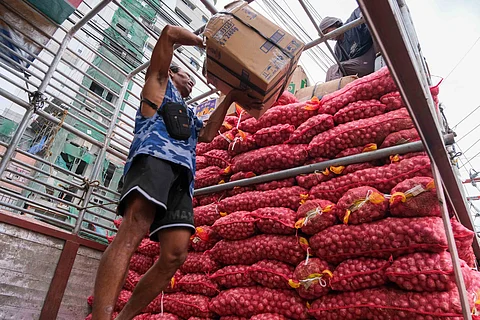
- NEWS
- the EDIT
- COMMENTARY
- BUSINESS
- LIFE
- SHOW
- ACTION
- GLOBAL GOALS
- SNAPS
- DYARYO TIRADA
- MORE

Secretary Francisco P. Tiu Laurel Jr. announced Saturday that the Department of Agriculture (DA) will establish the country’s first onion research and extension center, dedicated to revitalizing the industry. It will be located in Bongabon, the Philippines’ leading onion producer.
In addition to the research and extension center, the DA chief promised to help Bongabon’s farmers learn new technologies to boost farm productivity, benchmarking China’s best practices. He also vowed to double the funding for the procurement of pheromone lures, allocating up to P5 million to help onion farmers combat armyworms.
Tiu Laurel said the DA will also begin sourcing better onion seeds to help farmers increase their yields.
“Our goal is clear: Make the Philippines self-sufficient in onion production, eliminate the need for imports, and increase the income of local farmers,” Tiu Laurel said.
During the Sibuyas Festival, the DA chief also vowed to support efforts to strengthen technical capabilities with farmers’ cooperatives.
He urged Bongabon Mayor Ricardo Padilla and local government officials to actively participate in DA programs aimed at ensuring food security, price stability and curbing smuggling activities that affect onion farmers’ livelihoods.
While Nueva Ecija is known as the Philippines’ top rice producer, it is also the leading producer of onions, with Bongabon at the forefront. Based on 2024 data from the Philippine Statistics Authority, approximately 12,726.11 hectares of farmland in Central Luzon were planted with onions, producing 158,088.41 metric tons — 59.80 percent of the national output.
Bongabon accounted for about a quarter of the region’s onion production, or roughly 15 percent of the country’s total output last year.
Region Field Office III director Eduardo Lapuz said the planned research center in Bongabon, to be located at the Bongabon Agricultural Trading Center compound, will be the first in the country. It will help develop ways to better combat onion pests and diseases, improve seed quality, and bolster farm yields.
The national onion harvest reached 264,323.89 metric tons in 2024, a 4.48 percent increase from 2023. However, this still fell short of the projected demand of 270,000 metric tons this year.
In 2022, onion production rose to 241,033.09 metric tons, marking a 10.54 percent increase from 2021. This growth occurred amid record-high prices driven by a supply shortage worsened by delayed imports.
Prices for onions, an essential ingredient in Philippine cuisine, reached a record high of P700 per kilo in 2022. Data from the Bureau of Plant Industry estimated monthly consumption at 17,000 metric tons for red onions and 4,000 metric tons for white onions.
Tiu Laurel said increasing local production will be sufficient to meet domestic demand and ensure stable prices.
In addition to post-harvest facilities, the DA offers production support services, including high-quality seeds, farm inputs, fertilizers and pest and disease management assistance to boost output and improve quality.
